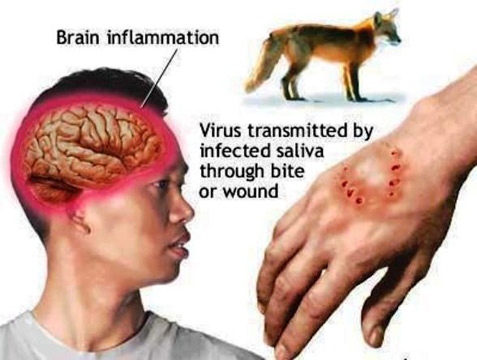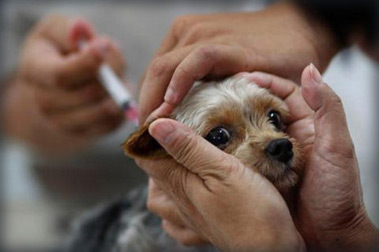|

Killing the killer disease rabies
By Carol Aloysius
It is a killer disease. No one in recorded history has been known to
have survived it. More frightening still, there are no drugs, no
surgical methods or even vaccines that can cure it once the virus has
entered your body.
Rabies is a terrifying viral disease. Those infected by the rabies
virus die an agonising death shortly afterwards. They are unable to eat
or swallow. Drinking water causes terrible spasms of the throat and
gives them a fear of water (hydrophobia).
Rabies can infect anyone at any time. A disease that infects humans
and warm blooded animals, its main transmitter is the dog. Ninety five
percent of the disease is spread by dogs while the remaining five
percent by rabied cats, dogs, mongoose, squirrels that have scratched,
bitten or licked a human being.
The disease, however, is preventable. According to Health officials,
one of the commonest ways the disease is transmitted to humans is by
domestic or household pets.
These pets (largely dogs,) if not vaccinated according to the
scheduled rabies immunisation dates could become infected if they come
in close contact with an infected dog, cat or any other rabied animal.
“The anti rabies vaccine is administered free to all dogs - whether
owned or free roaming dogs (stray dogs dog.) Owners must remember to
give the vaccination on the due dates. Delaying to do so can expose them
to rabies”, speakers from the Public Health Veterinary Services, Health
Ministry, told the media at a recent discussion at the Health Education
Bureau.
Excerpts...
Director, Public Health Veterinary Services (PHVS) Dr P.A.L
Harischandra opening the discussions said that his unit had been
entrusted with the national program to preventing human and animal
rabies and controlling other zoonotic disease in Sri Lanka. Rabies
control was the main zoonotic program in the country and since 1990 it
had been decentralised with the Provincial health services being
responsible for implementing the program.
|

Rabies is a viral encephalitis transmitted to humans by the
bite of an infected animal, usually a dog, fox or bat. |
“Rabies is by no means a new disease in Sri Lanka. There is strong
evidence to indicate the menace of rabies had existed in our island for
over several centuries. So much so, that our Colonial rules had been
compelled to adopt legislation to control the disease. The Rabies
Ordinance of 1893 and Dog Registration Ordinance of 1904 are perhaps
some of the oldest legislation passed by any country in the region or
even the entire world”, he said.
In spite of having these ordinances, and the fact that rabies had
been recognised as an important public health problem in Sri Lanka from
early 1950s, he observed that official statistics to gauge the rabies
situation in the island were only available after the 1970s.
Explaining the disease and how it spreads he said, “Rabies is a
zoonotic viral disease which affects domestic and wild animals. It is
transmitted to other animals and humans through close contact with
saliva from infected animals (i.e. bites, scratches, and licks on broken
skin and mucous membranes).
Worldwide, the dog is the main transmitter or rabies to man. “Once
the symptoms of the disease develop, rabies is fatal to both animals and
man. Our goal is to give maximum protection to the public from this
deadly disease”, he stressed.
To do this, he said the Health Ministry had several objectives in its
National Program to Eliminate Rabies.
They include the following:
1. Ensure protection for those exposed to suspected rabies infection.
2. Ensure protection for those who are at a higher risk of contracting
rabies e.g. public health workers, dog catchers.
3. To establish herd immunity in animal reservoirs with special emphasis
on dogs.
4. To control the population of animal reservoirs with special emphasis
again on dogs, through appropriate methods.
5. Remove all rabies suspected dogs humanely.
In addition, he said several innovative far sighted strategies were
being put into place.
These include:
1. Proper screening of animal bite victims for decision making on
post exposure management.
2. Provide appropriate post exposure treatment equitably to the
population as a whole.
3. Encourage pre-exposure prophylaxis for those engaged in
occupations at higher risk of exposure t rabies infections.
4. Immunise all dogs (domestic, community and stray) through ass
vaccination campaigns to achieve 75 percent coverage.
5. Encourage participation of both private and public sector
veterinary services in providing vaccination to dogs.
6. Sterilse dogs through appropriate chemical and surgical methods.
7. Control of environmental conditions in public places conducive to
propagation of dogs.
8. Removal of nuisance dogs by proper authorities through humane
methods.
9. Develop a mechanism to identify all suspected or rabied animals.
10. Strengthen rabies surveillance.
11. Enact legislation to implement the National Rabies Policy.
“All these activities will be implemented by the Line Ministry and
Provincial Health authorities. Activities pertaining to policy
development, strategy development, training (curative and preventive
staff), mass awareness campaigns, supply of drugs, vaccines and other
major inputs, research and supervision are carried out by the PHVS
office of the Ministry of Health”, he said.
Provincial Health Services are responsible for implementing awareness
programs, administering anti rabies vaccinations and animal birth
control programs to eliminate rabies. Provision of Post Exposure
Treatment (PET) is carried out by line ministry and provincial
hospitals,” he said.
He added that expansion or rabies diagnostic facilities with training
of staff of the department of Animal Production and Health on Direct
Rapid Immunochemistry Test (DRIT) would further facilitate elimination
of the disease.
Consultant Virologist, Rabies Unit, Medical Research Institute (MRI)
Dr Kanthi Nanayakkara said that the rabies control measures launched in
Sri Lanka since 1975, have so far had a significant impact on the
incidence of human rabies. The numbers of human rabies deaths declined
from 377 in 1973 to 298 in 2013”, she said. She said that the MRI was
currently the country's biggest rabies research laboratory and received
several hundreds of specimens of suspected rabied animals daily. “We can
only accept carcasses of small animals such as dogs, rock squirrels,
mongoose, pole cats, monkeys and goats.
In the case of bigger animals such as cattle, we have informed the
health authorities in the provinces to ask owners to send only the heads
of such animals packed well in ice so that when they reach us we will be
able to conduct the tests accurately.” The total number of animal rabies
reported during 2013 was 762. The majority (87 percent) or 664 of animal
rabies was reported among dogs, 10.1 percent (77) in cats, 1.2 percent (
9) cows, 3 goats,).3 percent squirrels, 0.5 percent (4) mongoose and 0.1
percent (1 each 0 among rock squirrels, buffaloes and pole cats.
Our services are free and available to all who need animal rabies
testing. We do not test for human rabies,” she said. She said that the
MRI services were available all 365 days of the year and were open 24
hours of the day. “Anyone who wants information or wants to contact us
in an emergency, is free to do so”, she said.
The Public Health Veterinary officer Dr R.M.S. Pimburage, giving
examples of his own experiences in the rabies control program, said that
although the PHVS was now taking the program to the doorstep of dog
owners in villages, towns and rural and urban areas, there was still a
reluctance on the part of dog owners to bring their dogs for
vaccinations. “Some of them give us lame excuses such as: "We have
misplaced the cards and so we did not know the exact dates when the dogs
were immunised. This irresponsible behaviour is unacceptable.
Some (in the case of shared or community dogs) tell us they can't
afford to pay the registration fees although they are willing to look
after and feed the dogs.”
He said human rabies vaccines were also available free in hospitals
to all. However, in some cases people prefer to go to the village
vedamahatthaya and get treatment from him. By the time the patient is
brought to the hospital, he has already developed the disease”, he said.
He said that there were two kinds of rabies: animal rabies and human
rabies. Rabies in dogs is of two types: dumb rabies and ferocious
(furious) rabies. In dumb rabies dogs do not eat, become inactive and
lie in a corner most of the time. In furious rabies, the dog changes its
behaviour radically and becomes fierce, wildly attacking even members of
the household it loved.
“Once a person has been bitten by an infected animal, the virus
enters the body and the person develops the disease. The time interval
between the bite and the appearance of the disease is about 1-3 months
but could be less especially in children.”
|

A pet being vaccinated for rabies |
On the early symptoms of the disease, he said they included; severe
headaches, body aches and pains, loss of appetite, nausea, vomitting,
fever, difficulty in swallowing.
"Prevention is the most important measure. Immunise your dog and
don't let it stray onto the road and come into contact with non
vaccinated animals”, he stressed.
Rabies vaccine is given to dogs once a year. Ideally the first dose
should be given when the dog is between 3-6 months.
Commenting on the treatment procedure, he said the most important
thing was to scrub and thoroughly clean the wound with clean running
water and soap and surgical spirits . An ambulance should be called for
immediately and the patient should be rushed to hospital at once, so
that the doctor can examine him and make a decision on what to do next.
An anti rabies vaccine will be administered only on the doctor's
advice. If possible, the suspected rabied dog should be kept under
observation, or else a specimen of the dog should be sent to the MRI for
testing”.
Speakers said that a safe tissue culture vaccine was now available in
all state hospitals.
Senior Registrar in Community Medicine, PHVS, Dr Janaka Weragoda
discussing the costs of the rabies reduction program, said the Health
Ministry was spending millions of rupees on the rabies control and
treatment program. Out of the total expenditure of Rs 506 million spent
on dog rabies and human rabies vaccines, he said the import of dog
rabies cost Rs 31 million, human rabies vaccine Rs 231 million and dog
sterilisation Rs 125 million.
He said the program had been implemented in nine districts resulting
in 163,852 sterilised surgically, 36,372 dogs sterilised
chemically,1,340,199 stray and domestic dogs vaccinated against rabies,
and provision of thousands of serum vials for human rabies prevention.”
This has brought down the deaths by rabies to 28.We will continue to
further expand our program and strengthen our vigilance. We need the
co-operation of the public and the media to spread the message and
banish all wrong myths and notions on rabies”, he said.
New understanding of emotional impact of stroke
The physical challenges associated with recovery from a stroke are
well documented, however the impact of a stroke on emotion is less well
understood.
New research from the University of Aberdeen has identified key areas
in which stroke can impair emotion regulation and found that these
difficulties continued 18 months after the stroke.
 The findings of this study have implications for the long-term
treatment and recovery of stroke patients and may help pave the way to
help guide treatment interventions following stroke. The findings of this study have implications for the long-term
treatment and recovery of stroke patients and may help pave the way to
help guide treatment interventions following stroke.
Every year there are approximately 152,000 strokes in the UK, which
equates to one stroke every three and a half minutes.
Dr Clare Cooper, Lecturer in Health Psychology said: “Emotion
regulation is really important for all of us - we all use it every
second of every day.
It is about recognising what we are feeling and what we can do to
cope if we feel distressed.
For example we might count to ten or rant to a friend, thereby
enabling us to continue with our daily lives.Following stroke, emotion
regulation may be impaired and patients may struggle to understand and
cope with their own emotions. Following a stroke, patients can sometimes
experience their emotions as overwhelming and feel as if their emotions
are running them rather than other way round. This can seriously limit
the degree to which patients are able to live their life to the fullest.
“This study is the first of its kind to examine in detail how emotion
regulation is affected by a stroke and explore how this may influence
people's social participation following stroke.”
Researchers interviewed stroke patients six weeks after their stroke,
then again at 18 months into their recovery and compared their answers
to individuals who had not experienced a stroke.
The volunteers were asked questions about their ability to regulate
their emotions, which included questions about topics like impulsivity
and emotion awareness.
Patients were also asked about how much they engage in social
activities such as seeing friends and family, engaging in social events
and working. Results were then analysed to find any links between
emotion regulation and social participation.
Dr Cooper added: “Our results showed that at six weeks post-stroke,
patients showed impairments in emotion regulation that were related to
reduced social participation compared to a control group.
“At 18months post-stroke there was still an association between the
ability to regulate emotion and social participation, which was apparent
even when other factors such as low mood and mobility problems had been
accounted for.
“These findings show that following a stroke, some patients can have
long-term difficulties with emotional regulation and that this may
affect their ability to participate socially.
Although more research is needed we now have a clear starting point
for follow-up research to better understand how emotion regulation is
affected, how we might help patients cope with this, and whether this
leads to a more socially active and fulfilling life.
Research suggests that by giving patients strategies to recognise
feelings and control emotions they can focus on recovery and eventually
engage more fully with work and family.”
- MNT
Encouraging self-compassion for a positive body image
Women who accept and tolerate their imperfections appear to have a
more positive body image despite their body mass index (BMI) and are
better able to handle personal disappointments and setbacks in their
daily lives.
Research out of the Faculty of Arts at the University of Waterloo
found that this self-compassion might be an important means to increase
positive body image and protect girls and young women against unhealthy
weight-control practices and eating disorders.
 “Women may experience a more positive body image and better eating
habits if they approach disappointments and distress with kindness and
the recognition that these struggles are a normal part of life,” said
Prof Allison Kelly of the Department of Psychology at Waterloo, and the
study's lead author. “Women may experience a more positive body image and better eating
habits if they approach disappointments and distress with kindness and
the recognition that these struggles are a normal part of life,” said
Prof Allison Kelly of the Department of Psychology at Waterloo, and the
study's lead author.
“How we treat ourselves during difficult times that may seem
unrelated to our bodies and eating seems to have a bearing on how we
feel about our bodies and our relationship with food.”
This study adds to the growing body of literature suggesting that
self-compassion might offer unique benefits that self-esteem does not.
Self-esteem comes from evaluating oneself as above average, and so may
be limited in helping individuals cope with perceived shortcomings.
“Regardless of their weight, women with higher self-compassion have
better body image and fewer concerns about weight, body shape or
eating,” said Prof Kelly.
“There is something about a high level of acceptance and
understanding of oneself that helps people not necessarily view their
bodies more positively, but rather acknowledge their bodies’
imperfections and be okay with them.” The research results suggest that
eating disorder prevention and health promotion that focus on increasing
young women's self-compassion may be an important way to foster
healthier weight management across the BMI spectrum.
This study gathered data from 153 female undergraduate students and
used BMI calculations based on each participant's self-reported height
and weight.
- MNT
|

